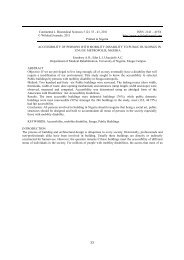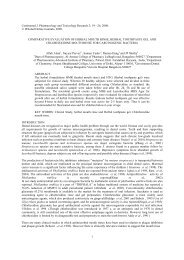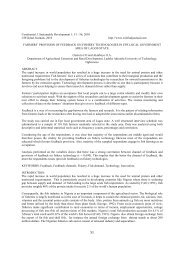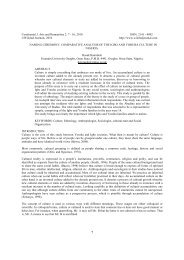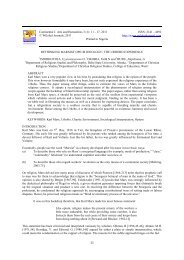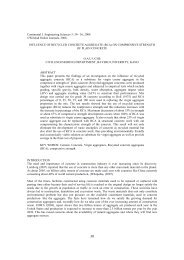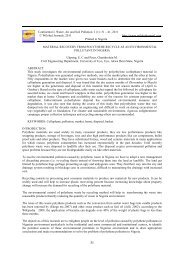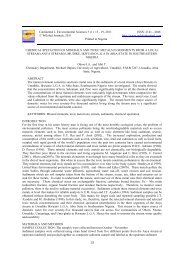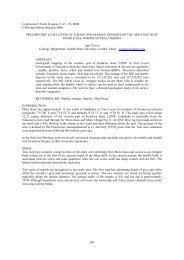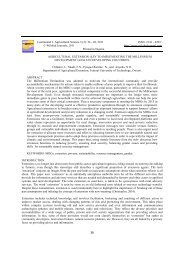O.R. Omobuwajo et al.,: <strong>Cont</strong>inental J. <strong>Pharm</strong>aceutical <strong>Sci</strong>ences 5: 1 - 10, 2011These two plants have been well researched by many workers and therefore qualified to be used in formulations of herbaldrugs. There are pharmacopoeia standards set for Senna alata leaves in the Nigerian Herbal <strong>Pharm</strong>copoeia (NHP,2008)Senna alata is also in the French <strong>Pharm</strong>acopeia (Hennebelle et al,2009)Ageratum conyzoides is a plant on the second list of plants to be included in the second volume of the Nigerian Herbalpharmacopoeia(NHP,2008).Senna alata commonly called ringworm, ‘craw craw’ plant or candle stick plant used for dermatitis, eczema ringwormgonorrhea (Dalziel, 1937, Irvine, 1961) is found in the rain forest and savannah areas in both the southern and northernparts of Nigeria. It is common in villages, wastelands and clearings and chiefly in the forest regions of Nigeria(Adjanohoun, et al1991Senna alata leaf contains reduced anthraquinone; aloe-emodin, rhein glycoside and aloe-emodin glycoside (Rai,1978).Kaempferol 3- O-gentiobioside and aloe emodin were also obtained from the leaf(Hazni et al 2008). Twelve compoundswere isolated from C. alata, which were identified as chrysoeriol, kaempferol, quercetin, 5,7,4'-trihydroflavanone ,kaempferol-3-O-beta-D-glucopyranoside , kaempferol-3-O-beta-D-glucopyranosyl-(1-->6)-beta-D-glucopyranoside, 17-hydrotetratriacontane , n-dotriacontanol , n-triacontanol , palmitic acid ceryl ester, stearic acid , palmitic acid (Liu et al,2009). Assay of leaves for flavonoid content by Akinmoladun et al (2010) showed the leaves contained 275.16=/-1.62microg/ml quercetin equivalent and significant antioxidant activity. Cassiaindoline, an indole alkaloid was isolated fromSenna alata and showed anti-inflammatory activity (Villaseñor et al 2009). Methanolic extract of the leaves of Sennaalata exhibited inhibition against Methicillin Resistant Staphylococcus aureus. Chrysophanol, physcion and kaempferolhave also been isolated from the root of Senna alata (Fernand et al, 2008).Senna alata leaves have shown antimicrobial and laxative activities (Elujoba et al 1989). The leaf and flower of S. alatashowed antimicrobial activity on unspecified Gram-positive bacteria and against Trichophyton rubrum and Basidiobolushaptosporus. Oil extracted from the leaf had inhibitory effects on Gram-positive and Gram-negative bacteria includingPseudomonas sp., Staphylococcus aureus and Escherichia coli (Ogunti et al 1991).Leaf extracts against were active againstPropionibacterium acnes, and Staphylococcus epidermidis which are the organisms implicated in acne (Chomnawang etal, 2005).Other investigations showed leaf extract to be active against Trichophyton tonsurans Microsporum soudanenseand more active than griseovulvin and clotrimazole (Eja et al, 2009). Leaves have been used to treat dermatophilosisinfected animals and there was no recurrence (Ali- Emmanuel et al 2003).A. conyzoides is widely utilized in traditional medicine by various cultures worldwide, although applications vary byregion. It is used to treat pneumonia,wounds and burns (Durodola,1977). It has also been used as a bacteriocide,antidysenteric, and antilithic (Borthakur and Baruah. 1987). It is used to treat fever, rheumatism, headache, and colic(Menut,1993; Vera, 1993) . A. conyzoides has quick and effective action in burn wounds and is recommended byBrazilian Drugs Central as an antirheumatic (Brasil, Ministério da Saúde, Central de Medicamentos, 1989; Akinyemi et al2005 ; Lans, 2007)Flavonoids, alkaloids, coumarins, tannins and essential oils have been obtained from A conyzoides. (Jaccoud,1961;Oliveira et al 1993.) Compounds which have been isolated from A conyzoides are conyzorigum, a cromene (Borthakur andBaruah. 1987), precocene I and precocene II, which have been shown to affect insect development, as antijuvenilehormones, resulting in sterile adults (Ekundayo et al, 1988).Other compounds, flavones, ageconyflavones A,B,C,hexamethoxy flavone, cumarinic compounds including 1-2 benzopirone and alkaloids of the pirrolizidinic group have beenisolated( Trigo et al, 1988). 51 terpenoid compounds were identified from volatile oil from A.conyzoides, includingprecocene I and precocene II (Gonzales, 1991.)11 cromenes in the essential oils, including 6-angeloyloky-7-methoxy-2,2-dimethylcromene were identified (Vera, 1993). Ageratocromene, and beta cariophylene were also obtained from Aconyzoides (Horie et al, 1993). Ether and chloroform extracts of the plant had inhibitory activity against Bacillus subtilis,Staphylococus aureus, Escheriachia coli and Pseudomonas aeruginosa (Almagboul et al 1985). Aqueous extracts showedanalgesic action and whole plant extracts had muscle relaxing activities (Achola et al, 1994).2
O.R. Omobuwajo et al.,: <strong>Cont</strong>inental J. <strong>Pharm</strong>aceutical <strong>Sci</strong>ences 5: 1 - 10, 2011MATERIALS AND METHODSPlant CollectionSenna alata leaves were collected from the Department of <strong>Pharm</strong>acognosy and Herbal Medicine, Niger Delta University,Nigeria, medicinal plant garden. The leaves were air dried for a few days and then ground. The powder stored in wellsealed containers away from light for further use.Ageratum conyzoides was collected from the grounds of the College of Health <strong>Sci</strong>ences, Niger Delta University, Nigeria.The soil was removed from the roots and washed with distilled water. The whole herb was air dried for a few days andground and stored in well sealed containers and stored away from light for further use.Plant PowderThe Plant material to be introduced was sieved to give a moderately fine powder according to the definition in the Qualitycontrol methods for medicinal plant materials by WHO. All particles will pass through a No. 355 sieve(Nominal aperturesize 0.355mm) and not more than 40% through a No. 108 sieve Nominal aperture size 0.180mm). After obtaining the gradeof powder desired, the powdered plant materials were weighed in equal amounts. The two plant materials were then siftedtogether to mix completely. The amount to be put into the soap mixture was then weighed out.Plant ExtractionOne hundred grams each of the two plant materials were weighed and extracted successively for 72 hours in the cold withmethanol. The extract was filtered and the extract concentrated in vacuo at room temperature using a rotary evaporator.The extract was stored at 4 o C till needed.Soap MaterialsPalm kernel oil (Pko)was obtained from local producers in the Osun State, Nigeria as the one obtained, locally in BaylesaState Yenagoa, Nigeria was full of burnt debris.Water – distilled waterNaOH- BDH analytical qualityMethodologyThe following soap formula was used to make a normal hand and body soap. This was scaled down to produce laboratorysize.2.3 liters of Pko0.36kg of NaOH0.9 liters of WaterThe cold method of soap making was used to prepare the herbal soap. The NaOH was dissolved in the water in a beakerand allowed to cool, poured gradually into the oil with continuous stirring. The plants materials were added gradually withstirring with a glass rod and the mixture was then poured into a rectangular pan and left to set.Soap containing three different percentages of plant material 3, 5 and 8%w/w were produced. The soaps were cut intosquares of 5cm by 5cm for ease of handling.Antimicrobial assessmentThe three formulations of soap and the extracts of the two plants were subjected to anti microbial tests using gram negativeand gram positive organisms and fungi. Typed and pathogenic organisms were used.METHODOLOGYThe agar-dilution method for the determination of minimum inhibitory concentration of antimicrobial agents approved byCLSI was employed (CLSI 2008). 5g of the herbal soap was suspended and dispersed in 10ml of sterile distilled water toobtain a stock suspension containing 500mg/ml. From this stock, dilutions were made by adding 1ml of the suspension to9ml of sterile molten Mueller Hinton agar in Petri-dishes to obtain a plate containing the soap at a concentration of3





